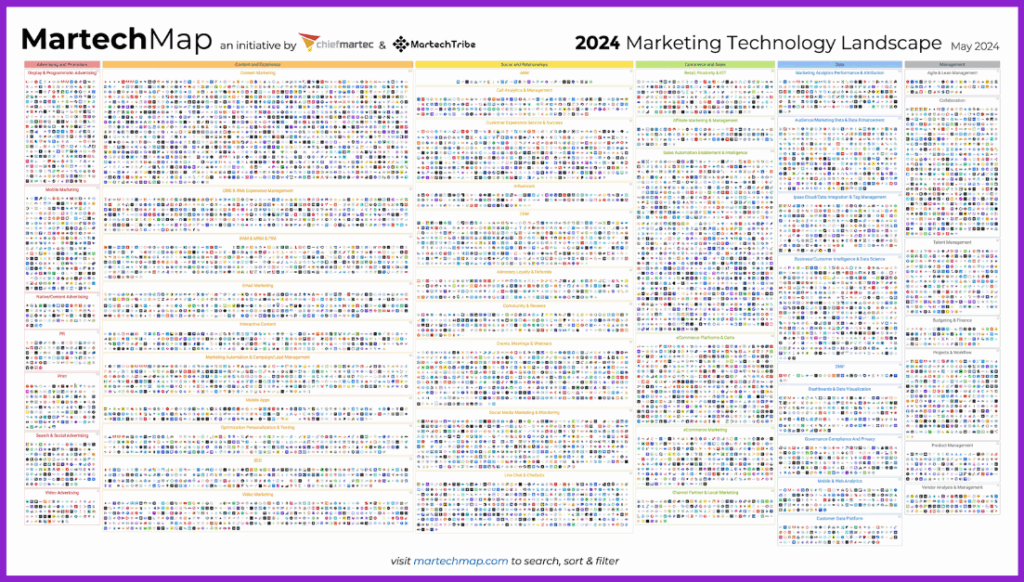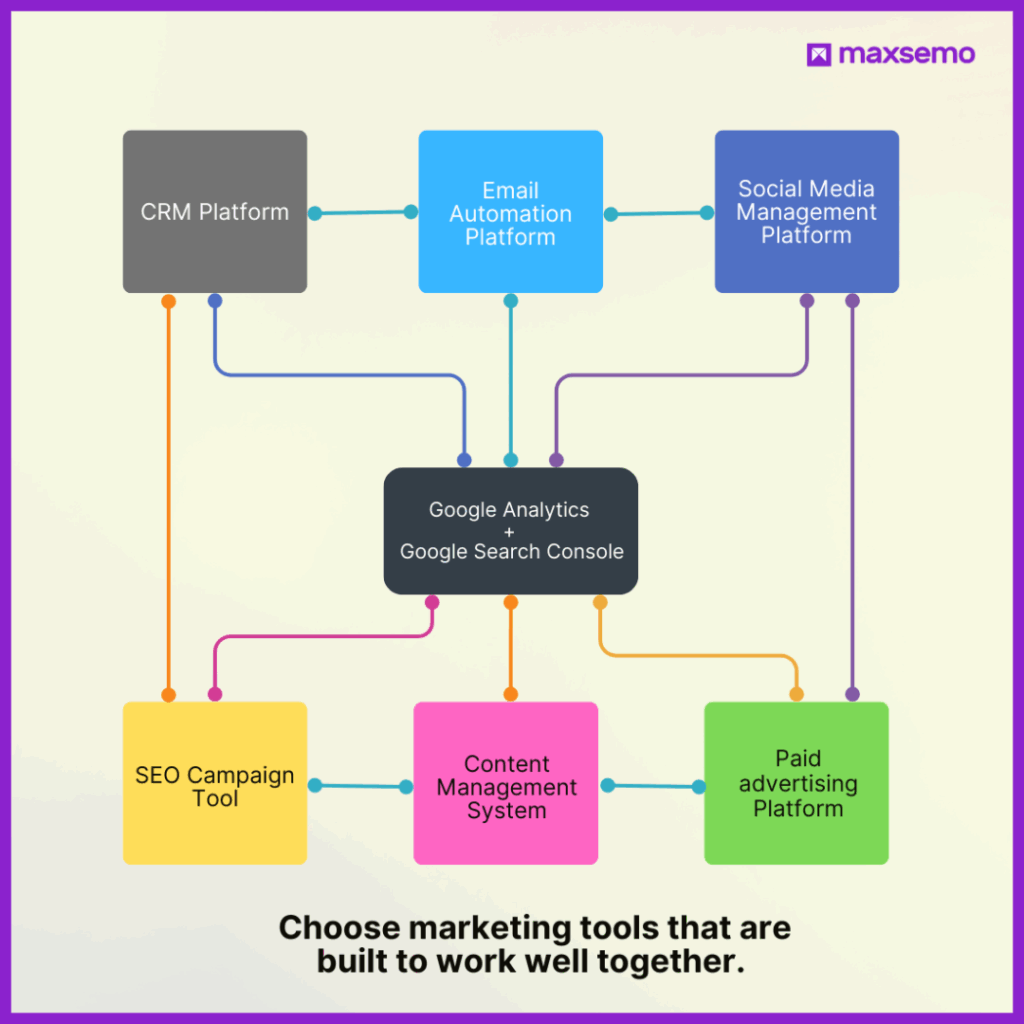
At first, the marketing team was excited.
A new tool for social media. Another for email campaigns.
A third one for analytics. Soon, their dashboard was packed with colorful apps – each promising to make their jobs easier.
But over time, things got messy. Data lived in silos.
Campaigns slowed down. Instead of helping, the tools became obstacles.
This is the hidden cost of an overloaded marketing technology (or martech) stack – and it’s more common than you think.
Today, building a lean and integrated martech system isn’t just smarter – it’s necessary for marketing teams that want to move faster and drive higher impact.
In this blog, we’ll guide you through how to rethink, rebuild, and reconnect your martech stack for real results.
What Does a Lean and Integrated Martech Stack Really Mean?
Before we dive deeper, let’s quickly recap what a martech stack actually is.
Simply put, a martech stack (or marketing technology stack) is the collection of technologies and tools that marketers use to plan, execute, manage, and measure their marketing activities.
It can include everything from CRM systems and email marketing platforms to analytics tools, social media schedulers, automation software and even AI agents for digital marketing campaigns.

marketing technology (martech) stack looks like.
Now, while having a variety of tools sounds empowering, it often leads to an overloaded stack where platforms don’t talk to each other, teams get overwhelmed, and marketing efforts lose focus.

This is where the concept of a lean and integrated martech stack comes into play.
A lean martech stack means:
- Every tool serves a clear, strategic purpose.
- There’s no duplication of functionality or “nice-to-haves” that add little real value.
- It’s built around core marketing needs, not the latest trends or shiny new tools.
An integrated martech stack means:
- All tools work together seamlessly, sharing data and automating workflows.
- It creates a single, connected view of the customer, enabling smarter decisions and more personalized experiences.
- It eliminates data silos, ensuring marketing, sales, and service teams are aligned.
When you build a lean and integrated martech system, you’re not just cutting costs -you’re building a smarter, faster, and more impactful marketing engine that directly supports business growth.
The Hidden Costs of an Overloaded and Disconnected Martech Stack
At first glance, adding more tools to your marketing technology stack seems like a way to strengthen your marketing efforts.
But beneath the surface, an overloaded and disconnected stack quietly chips away at your efficiency, effectiveness, and profitability.
Here’s how:
1. Wasted Budget
When tools overlap or go unused, money quietly leaks from your overall marketing budget.

A Gartner study highlighted that organizations use only about 33% of their marketing technology stack capabilities, leading to substantial budget waste.
2. Poor Data Quality and Fragmentation
Disconnected systems lead to inconsistent data across channels, making it harder to deliver personalized experiences.
According to Experian, 75% of organizations believe inaccurate data is undermining their ability to provide an excellent customer experience.
3. Lower Team Productivity
Switching between multiple disconnected tools slows down workflows, causes duplicate work, and leads to burnout.
One study showed that siloed digital tools are making it hard for surveyed employees (44%) to gauge whether work is being duplicated.
In that, nearly half of the surveyed employees said that the difficulty in tracking their work led to mistakes on the job.
4. Inconsistent Customer Experience
When tools don’t talk to each other (not just within marketing department), customers experience gaps – like receiving conflicting messages or facing slow support responses.
Salesforce says that 55% of customers who participated in their survey feels like they are communicating with separate departments rather than one company.
5. Higher IT and Maintenance Costs
Managing a large stack requires more technical oversight – including updates, security patches, and integration maintenance – which strains IT resources.

Integration maintenance, support tickets, and workflow complexity create an “invisible tax” on IT and operations, often leading to teams spending more time fixing issues than executing campaigns.
Steps to Build a Lean and Integrated Martech Stack
Building a lean and integrated marketing technology (martech) stack isn’t about starting from scratch or buying the most popular tools.
It’s about making smarter, more strategic choices that align with your marketing goals, your team’s needs, and your customers’ journey.
Here’s how you can do it step-by-step:
1. Define Your Core Marketing Objectives
Start by getting crystal clear about what you want your marketing to achieve.
Whether it’s generating leads, improving customer retention, boosting brand awareness, or all of the above – your objectives will guide every technology decision you make.
Ask yourself:
- What are our primary marketing goals for the next 12–24 months?
- What specific problems are we trying to solve?
2. Audit Your Existing Tools
Before adding anything new, take stock of what you already have.
Identify which tools are critical, which ones are redundant, and which ones are gathering dust.
Look for:
- Overlapping functionalities
- Tools with poor adoption rates
- Platforms that don’t integrate well with others
3. Prioritize Integration and Interoperability
Choose tools that are built to work well together.
Look for platforms with strong APIs, native integrations, and ecosystem partnerships.

The goal is to create a seamless flow of data across your stack – not isolated islands of information.
Tip: Whenever possible, favor multi-functional platforms that cover several needs without sacrificing depth.
4. Focus on Essential Categories First
Instead of chasing every new trend, make sure you have the core building blocks in place:
- CRM (Customer Relationship Management)
- Marketing Automation
- Analytics and Attribution
- Content Management
- Customer Data Platform (optional but valuable for scaling)
Once your essentials are strong, you can selectively add specialized tools.
5. Involve Your Team in Tool Selection
Your marketing, sales, and service teams are the ones who will actually use these tools.
Get their input early – what do they need, what frustrations do they have, and what features will genuinely make their work easier?
This helps you:
- Choose tools people will actually use
- Improve adoption rates
- Build cross-functional buy-in
6. Think Scalability, Not Just Current Needs
Pick solutions that can grow with your business.
A tool that works perfectly for a team of five might break down when you scale to fifty.
Future-proof your stack by thinking about both your current and next-stage needs.
7. Regularly Review and Optimize
A martech stack isn’t a “set-it-and-forget-it” project.
Schedule regular reviews (every 6–12 months) to assess performance, eliminate redundancy, and adjust based on new business priorities or market changes.
Few Examples of a Lean Martech Stack
A lean martech stack doesn’t look the same for every organization.
It depends on your industry, your business model, and the kind of customer experience you want to deliver.
Here are a few industry-specific examples of how a streamlined and integrated martech stack can come together:
1. E-commerce Business
Core Needs: Product marketing, customer retention, personalized experiences.
Sample Stack:
- Shopify (E-commerce Platform & CMS)
- Klaviyo (Email & SMS Marketing Automation)
- Google Analytics 4 (Customer Behavior Tracking & Attribution)
- Yotpo (Customer Reviews & Loyalty Programs)
- Hotjar (Website Behavior Analytics)
Why It’s Lean: Each tool covers a critical stage of the customer journey – from browsing to purchase to retention – with minimal overlap.
2. SaaS Company
Core Needs: Account-based marketing, nurturing, customer onboarding.
Sample Stack:
- HubSpot (CRM + Marketing Automation)
- WordPress (Website & Content Management)
- Clearbit (Lead Enrichment & Targeting)
- Amplitude (Product Analytics)
- ZoomInfo (Sales Prospecting Database)
Why It’s Lean: The stack is built around understanding user behavior, nurturing leads effectively, and equipping the sales team with quality data.
3. Healthcare Services Provider
Core Needs: Appointment booking, patient engagement, compliance.
Sample Stack:
- Salesforce Health Cloud (CRM Tailored for Healthcare)
- Pardot (Marketing Automation for Healthcare Campaigns)
- Calendly (Patient Appointment Scheduling)
- SurveyMonkey (Patient Feedback Collection)
- Google Analytics 4 (Performance Tracking)
Why It’s Lean: Tools are selected to balance HIPAA-compliant engagement with efficient appointment management and insights.
4. Hospitality Business (Hotels, Resorts)
Core Needs: Direct bookings, guest experience personalization, reputation management.
Sample Stack:
- Little Hotelier (Property Management System + Booking Engine)
- Mailchimp (Email Marketing & Guest Loyalty Programs)
- Reputation.com (Review Management & Customer Feedback)
- Google Analytics 4 (Campaign Measurement)
- Canva for Teams (Creative Content for Social Media)
Why It’s Lean: This stack focuses tightly on direct revenue generation, brand reputation, and customer engagement without extra clutter.
5. Education/Online Learning Platform
Core Needs: Student acquisition, engagement, retention.
Sample Stack:
- Teachable (Course Hosting & Sales)
- ActiveCampaign (Email Automation & CRM)
- Google Tag Manager + GA4 (User Behavior Tracking)
- Typeform (Student Surveys & Feedback Collection)
- Zapier (Connecting Apps & Automating Workflows)
Why It’s Lean: The focus is on driving sign-ups, nurturing students, and optimizing based on engagement data – all with minimal manual effort.
Common Mistakes to Avoid When Building a Marketing Tech (Martech) Stack
Even with the best intentions, many marketing teams fall into familiar traps when assembling their martech stack.
Recognizing these pitfalls early can save you time, money, and a lot of frustration.
Here are some of the most common mistakes to watch out for:
1. Chasing trends: Adding tools just because they’re new, not because you need them.
2. Poor integration: Choosing tools that don’t connect smoothly with each other.
3. Overcomplicating: Building a complex stack that slows down your team.
4. Skipping user training: Not investing in onboarding and proper usage.
5. Ignoring scalability: Picking tools that can’t grow with your business.
6. Never auditing the stack: Letting outdated or unused tools pile up.
7. Focusing only on cost: Choosing cheap tools without considering long-term value.
Final Thoughts
Building a lean and integrated martech stack isn’t about having the most tools – it’s about having the right ones working together seamlessly.
By staying focused on your real needs, ensuring integration, and avoiding common pitfalls, you can create a system that drives higher impact with less complexity.
Looking for marketing strategies that can fuel your business growth?
Explore more insightful blogs on Maxsemo and find the strategies best suited to your journey!
